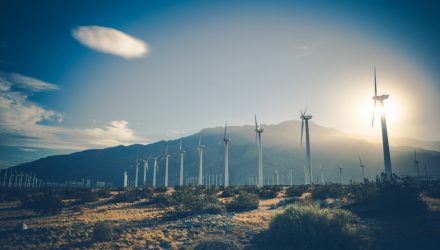Renewable energy ETFs, including the ALPS Clean Energy ETF (ACES), are hot this year, but that bullishness isn’t a fad. It’s part of a broader, longer-term trend backed by favorable fundamentals and positive implications.
Bolstering the near-term case for ACES is that renewables continue pilfering share from dirty coal, in part explaining why the fund is higher by 27.11% in the current quarter.
“Although U.S. net generation in April fell 6.6% below the same month in 2019, renewable generation has continued to grow as a source of the nation’s supply and surpassed nuclear and coal for the second month in a row,” reports S&P Global Market Intelligence. “Renewables accounted for 23.3% of the total, expanding its lead on nuclear generation as the second-largest source of power supply. A nuclear generation made up 21.5% of the nation’s electricity, while gas-fired generation remained the largest supplier of power with a 39.3% share.”
Data Come Up ACES
ACES follows the CIBC Atlas Clean Energy Index. That benchmark is comprised of U.S. and Canada-based companies that primarily operate in the clean energy sector. Constituents are companies focused on renewables and other clean technologies that enable the evolution of a more sustainable energy sector.
Data confirm that domestic utilities are generating less power via coal and more with alternative energy sources, such as wind and solar, potentially representing a long-term boon for ACES and its components.
“Year-to-date through April, utility-scale generation declined 4.1% year on year to 1.24 billion MWh,” according to S&P Global Market Intelligence. “Renewable generation grew 4.9% on the year to 257.8 million MWh, as the decrease in other renewable sources was offset by solar and wind.”
The growth of wind and solar is relevant to ACES because the fund allocates about 45% of its total weight to companies in those industries.
Producers of wind power are working to bolster efficiency with the aim of creating economies of scale that reduce costs and boost output. Should those objectives be realized, wind could add to its already-dominant renewables perch while continuing to steal market share from traditional fossil fuels.
Other alternative energy ETFs include the First Trust Global Wind Energy ETF (FAN) and the SPDR Kensho Clean Power ETF (CNRG).
For more on cornerstone strategies, visit our ETF Building Blocks Channel.
The opinions and forecasts expressed herein are solely those of Tom Lydon, and may not actually come to pass. Information on this site should not be used or construed as an offer to sell, a solicitation of an offer to buy, or a recommendation for any product.








